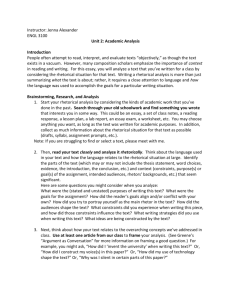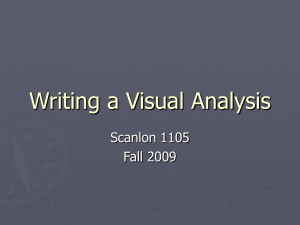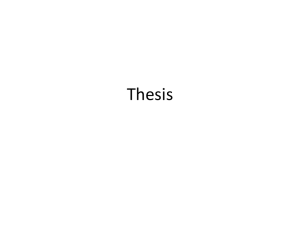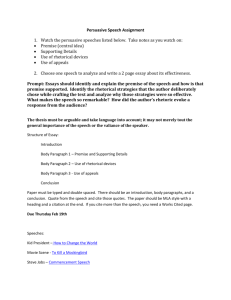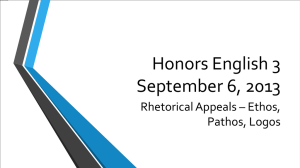Assignment sheet
advertisement
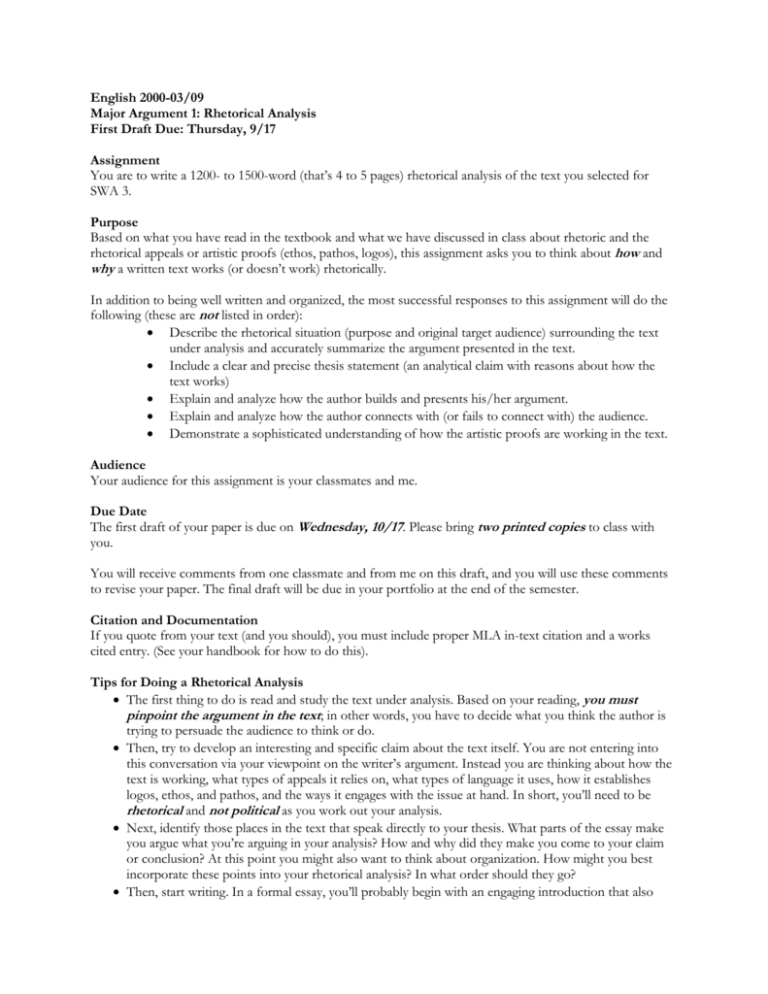
English 2000-03/09 Major Argument 1: Rhetorical Analysis First Draft Due: Thursday, 9/17 Assignment You are to write a 1200- to 1500-word (that’s 4 to 5 pages) rhetorical analysis of the text you selected for SWA 3. Purpose Based on what you have read in the textbook and what we have discussed in class about rhetoric and the rhetorical appeals or artistic proofs (ethos, pathos, logos), this assignment asks you to think about how and why a written text works (or doesn’t work) rhetorically. In addition to being well written and organized, the most successful responses to this assignment will do the following (these are not listed in order): Describe the rhetorical situation (purpose and original target audience) surrounding the text under analysis and accurately summarize the argument presented in the text. Include a clear and precise thesis statement (an analytical claim with reasons about how the text works) Explain and analyze how the author builds and presents his/her argument. Explain and analyze how the author connects with (or fails to connect with) the audience. Demonstrate a sophisticated understanding of how the artistic proofs are working in the text. Audience Your audience for this assignment is your classmates and me. Due Date The first draft of your paper is due on Wednesday, 10/17. Please bring two printed copies to class with you. You will receive comments from one classmate and from me on this draft, and you will use these comments to revise your paper. The final draft will be due in your portfolio at the end of the semester. Citation and Documentation If you quote from your text (and you should), you must include proper MLA in-text citation and a works cited entry. (See your handbook for how to do this). Tips for Doing a Rhetorical Analysis The first thing to do is read and study the text under analysis. Based on your reading, you must pinpoint the argument in the text; in other words, you have to decide what you think the author is trying to persuade the audience to think or do. Then, try to develop an interesting and specific claim about the text itself. You are not entering into this conversation via your viewpoint on the writer’s argument. Instead you are thinking about how the text is working, what types of appeals it relies on, what types of language it uses, how it establishes logos, ethos, and pathos, and the ways it engages with the issue at hand. In short, you’ll need to be rhetorical and not political as you work out your analysis. Next, identify those places in the text that speak directly to your thesis. What parts of the essay make you argue what you’re arguing in your analysis? How and why did they make you come to your claim or conclusion? At this point you might also want to think about organization. How might you best incorporate these points into your rhetorical analysis? In what order should they go? Then, start writing. In a formal essay, you’ll probably begin with an engaging introduction that also includes your very specific thesis statement. (For example, “Janice Turner uses several different kinds of arguments in her article ‘Cutting Edge’” is vague and uninformative. Here’s a better thesis: “In ‘Cutting Edge,’ Janice Turner seems to present only the facts about cosmetic surgery, but her word choices and examples affect readers’ emotions just as strongly as their brains.”) Early in your paper, identify the rhetorical situation for the article or essay you’re analyzing. In other words, explain who you think the target audience is and why you think the author wrote the piece. This discussion will provide important background information for your readers. As you move into the body of your essay, you’ll need to analyze the elements of the text you have identified in your thesis. You do this by first summarizing or even quoting the portion of the text you want to deal with. It’s your job to provide context for such descriptions. Next, use your own writing and thinking to demonstrate how this section of the text is working in reference to your claim. Be very clear about how this particular section of the text advances what you intend to say about the article as a whole. This is your analysis section, and it’s the most important thing you will do in this paper. Finally, conclude your essay with a synthesis of the analytical work you’ve done, and leave your reader with something interesting to think about in the conclusion. If you get stuck, return to the rhetorical analysis section of Present Tense (beginning on page 51). Remember that there’s a sample rhetorical analysis for you to reference (58-60). What should not be included in your rhetorical analysis Keep in mind that your focus is not on your own opinion about the topic being discussed in the article, but on explaining how the author of the article has put together her argument and how she appeals to the audience. In other words, if you were writing about an essay discussing the war in Iraq, what you think about the war would not be the focus; rather, you would need to show how the author argues her point and how her strategy is working.


